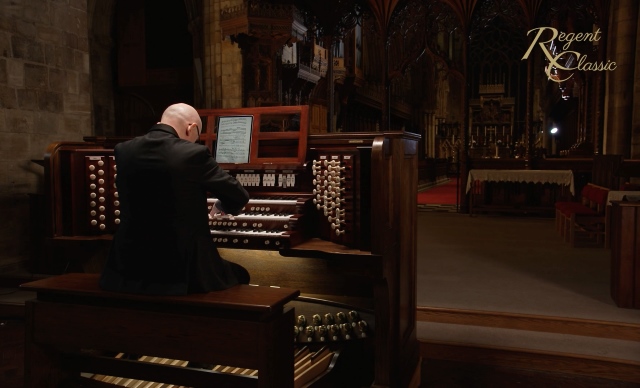Joseph Nolan plays a Regent Classic custom organ at Selby Abbey
Early in 2025, Regent Classic took its latest hire organ to Selby Abbey for a recording session with celebrated British-Australian organist, Joseph Nolan. The new custom hire organ was destined for St. John’s College, Cambridge, and will serve as a temporary instrument in the chapel while the current Mander organ is replaced by a rebuilt Willis from St Peter’s Church, Brighton. It has a stop list identical to that of the Willis rebuild, and some 21st century features that Father Willis himself might have found intriguing, such as a Bluetooth iPad page-turning piston that you will see used on some of these recordings, and a phone charging port.
For the Selby recording the instrument was temporarily installed in the Abbey with the speaker system that Regent Classic had previously put in the nave triforium. Over the course of a January evening after the doors had closed to the public, Joseph recorded the Messerer arrangement of Bach’s D minor Chaconne and Boëllmann’s Suite Gothique.

Suite Gothique by Léon Boëllmann
Léon Boëllmann’s Suite Gothique was written in 1895, and is one of those works that almost every organist knows in one way or another. Boëllmann was schooled at the famous École Niedermeyer in Paris and became a particular favourite of the more well-known Eugène Gigout (who apparently even raised Boëllmann’s children after he and his wife died rather too young). Boëllmann composed a surprisingly large number of works during his relatively short life, including for organ, piano, chamber ensemble and orchestra. Most of these are rarely heard these days, but the Suite Gothique has endured, possibly because it has some not-too-hard movements that nonetheless have quite a striking effect. The Toccata is a particular favourite in the organ world.
The Suite consists of four movements: Introduction–Choral; Menuet gothique; Prière à Notre-Dame; Toccata. The first two of these are included here as one because they are designed to be played Enchaînez, in other words with the Menuet following on immediately from the first movement. Apart from the Prière, these movements don’t have a great deal of subtlety in tone colour, being rather strongly dependent on the fullish fonds et anches sound world, but they do make use of the wide dynamic range of the instrument

Movement: Introduction–Choral and Menuet gothique
The Introduction is a short but grand chorale-like movement in C minor, which alternates between each stanza played on full organ and virtually the same thing repeated on full swell with the box closed. The final phrase echoes only the last four bars of the full organ, ending on a dominant chord that leads neatly into the Menuet.
The Menuet gothique is in the major key and has a bright dance-like feel. In contrast to the first movement, it alternates between closed full swell and full organ in the opposite sense. To begin with the sections are played quietly before being repeated double forte. In the central section this dynamic pattern swaps round again, developing a quaver movement motif alternating with snatches of the opening theme. The central section concludes with scalic passages accompanying the main motif, on a gradual crescendo, leading to a restatement of the main theme on full organ alone.
Movement: Prière à Notre-Dame
Prière à Notre-Dame is in many ways the best of the four movements, being a gentle prayer to the Virgin Mary played initially on the Swell string (including celestes) stops. In the central section, the organist plays on the Great, a flute coupled to the Swell strings, for a fuller sound. Here the theme is developed in a chromatic fashion, moving through a number of transitional harmonic regions. Joseph makes imaginative use of the Swell Trumpet (in this context voiced as a trompette harmonique), adding variety during the second part of the central section, a combination that was favoured by organ composers of the time such as Guilmant. We return to the main theme on the strings, ending with a rising arpeggio on the flute in the left hand.
I’m a retired academic, with a background in music and audio engineering. I’m currently a consultant for Viscount & Regent Classic Organs, as well as being a freelance organist, including a role as organist/choirmaster at St Mary’s, Witney. I sing bass with Oxford Pro Musica Singers and the Cathedral Singers of Christ Church, Oxford.


